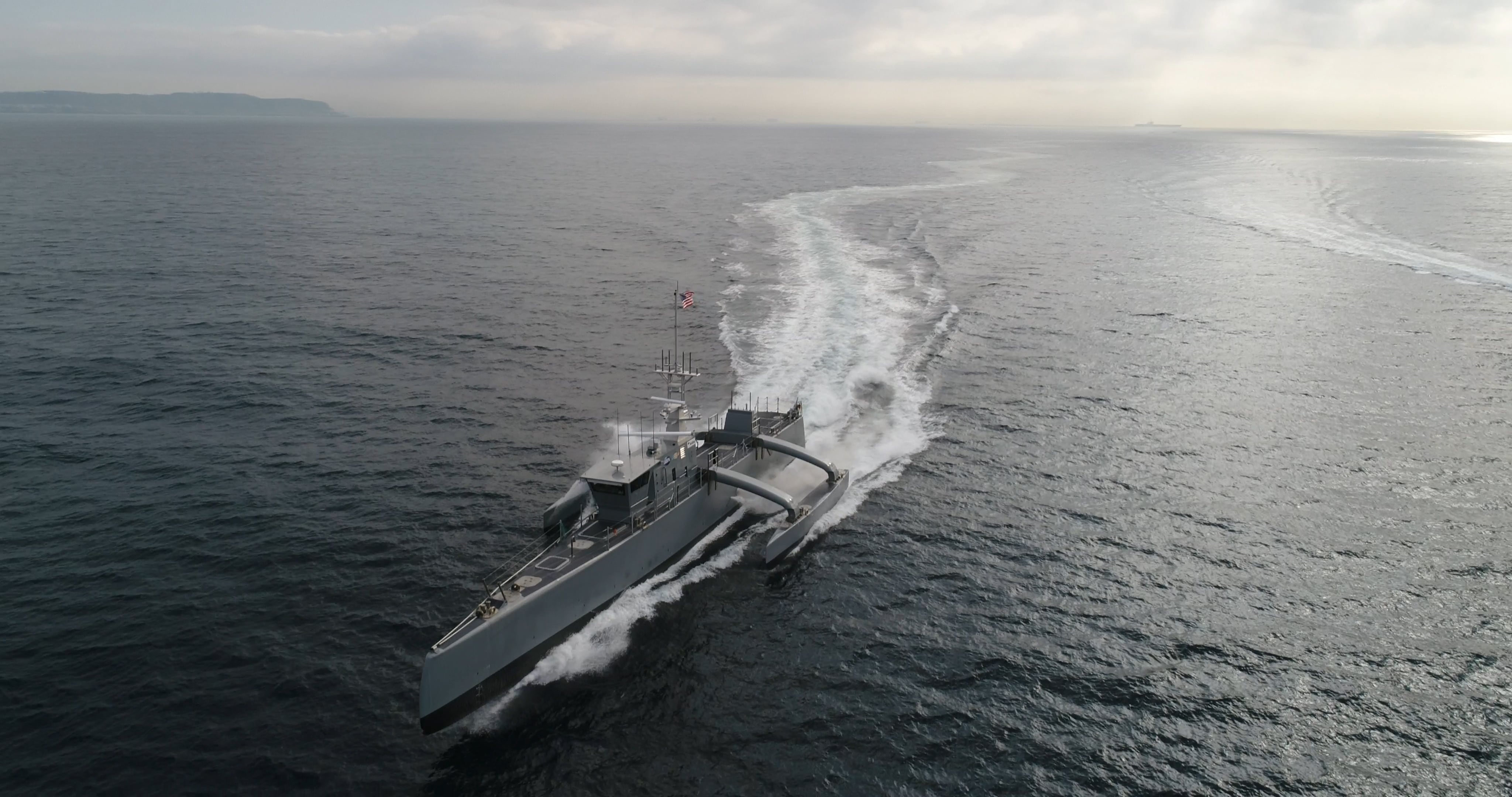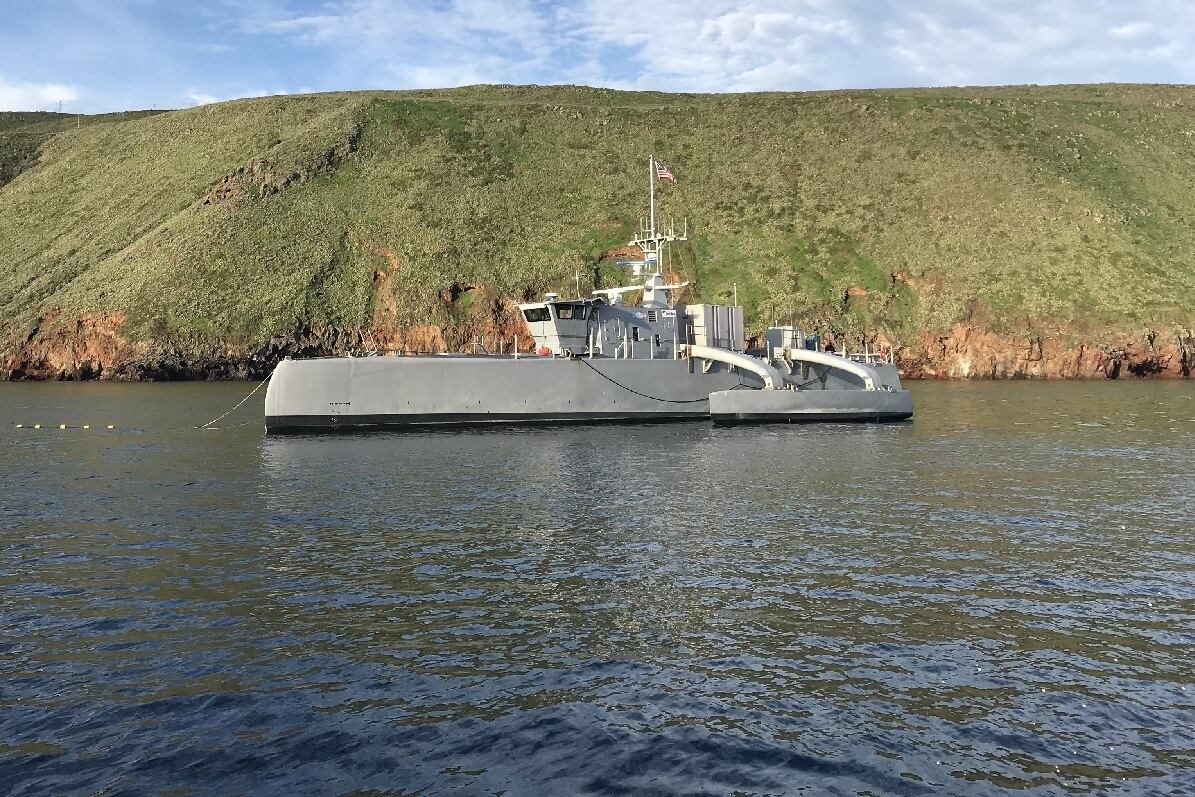WASHINGTON — The U.S. Navy’s yearlong fight to convince lawmakers it needed a significant investment in unmanned ships the size of offshore patrol vessels resulted in a kind of half victory.
The Navy kicked off the drive this year, announcing it was programming $2.7 billion in funding to develop and field unmanned platforms over the next five years, during which it will buy two large unmanned surface vessels per year.
Congress approved the purchase of two large unmanned surface vessels, or LUSVs, but forbade the service from integrating a vertical launching system, which is where the Navy anticipates many of the technical difficulties inherent in its concept reside.
But now that the program is going forward, what exactly is the Navy buying and what are the next steps?
Here are some some answers to a few of the questions you might have about the Navy’s pursuit of big robot missile-shooting boats.
RELATED

1. What exactly is the Navy buying in 2020? The Navy, spearheaded by Capt. Pete Small of the Program Executive Office Unmanned and Small Combatants, plans to buy two commercial fast-supply vessels, or FSV, which are used by the oil and gas industry to support offshore infrastructure. Those boats will be added to two similar boats procured by the Office of the Secretary of Defense’s Strategic Capabilities Office for its Ghost Fleet Overlord program.
Ghost Fleet Overlord converted two FSVs into unmanned surface vessels and demonstrated “autonomy system integration; demonstration of navigational autonomy; and hull, mechanical and electrical system reliability upgrades,” according to an October news release from Small’s office.
The first phase of Overlord wrapped up this year with the boats demonstrating they can follow the rules of navigation on their own.

2. What does the Navy want these things for? The Navy envisions the final product as an external missile magazine that can autonomously find its way to the fleet, expend missiles and work its way back to reload.
At a conference last fall, the Navy’s top requirements officer, Vice Adm. James Kilby, described it this way:
“We want to create an unmanned magazine," said Kilby, who heads the Office of the Chief of Naval Operations’ war-fighting requirements and capabilities office.
“And if you think about [it] from [that] perspective and I use that in conjunction with another force element where I can integrate fires, pass fire control from that element to the unmanned vehicle and deplete that magazine, send it back to reload, go back to using my magazine, wait for the unmanned magazine to return — I can sustain the fight longer.”
Essentially the Navy is looking for a cheaper way to increase the number of vertical launch tubes in the fleet without, as Chief of Naval Operations Michael Gilday put it last year, wrapping a $2 billion destroyer hull around 96 missile tubes.
3. How does the service plan to get there? The Navy’s plan is to build a fleet of prototypes to get lots of hours of experimentation in while gaining experience operating autonomous surface vessels.
Here’s how Small, who heads the Unmanned Maritime Systems office inside PEO Unmanned and Small Combatants, explains it:
“Our FY20 plans for our large USVs focused on two areas,” Small said during a June appearance at an American Society of Naval Engineers conference. “One area is: Get more prototypes out there. Some of our technical risk is in integrating military capabilities. So we need the prototypes to start integrating those capacities and burn down some of that risk.
“The other piece of that is demonstrating reliability. We are going to have to do a lot of testing to demonstrate reliable autonomous behavior: We need tens of thousands of hours of USV operations to demonstrate the reliability we need.
“Having one prototype or two prototypes is not going to get us to tens of thousands of hours of operations in the time frame we think we are going to need to employ the capabilities. So we need more prototypes to get there and burn down the technical risk of the payload integration.”
In the meantime, the head of Fleet Forces Command tasked surface navy boss Vice Adm. Richard Brown to deliver a concept of operations by the end of the year that will, first and foremost, figure out what a working LUSV and medium unmanned surface vessel should be able to do for the fleet.
RELATED

4. What are the issues? Many. First, nobody knows if this is workable program, which is what the prototyping effort will determine. Program officials are quick to point out that autonomy is probably not where they will have issues.
“A lot of the prototyping we have been doing has been doing a great job to develop that technology, and it is ready to support the kind of modular approach we are taking with these craft,” Small said in June.
“You know, it took me some time in this job to get over the surprise of meeting someone who tells me they are the world’s leading expert in 'X' autonomous technology, and they’ve been doing it for 20 years. And it’s true: There is a lot of technology out there, we just need to package it together and demonstrate it.”
The issue is really, from a technical standpoint, whether it’s possible to integrate exquisite communications suites, vertical launching systems, combat systems and missile systems into an unmanned ship, and then operate it from over the horizon or even just close by. It would be no mean feat, and the Navy’s long delays fielding littoral combat ship mission modules and new technologies from the Ford-class aircraft carriers have hardly inspired confidence on Capitol Hill.
“In view of uncertain LUSV concepts of operations, requirements, technical maturity — including many [first-of-a-kind capabilities] — the contrast between a proven aircraft carrier and its air wing and unproven unmanned surface vessels is stark,” a source familiar with the thinking of congressional authorizers told Defense News in December.
The recent Defense appropriations bill that funded the two LUSVs also forbade the Navy from integrating a vertical launching systems in the first boats but said it could revisit the issue in later years, which sprung from congressional concerns that the Navy was moving too fast.
5. So what’s next? Small’s office is going to keep testing prototypes and developing requirements in conjunction with the Surface Development Squadron. SURFDEVRON is the outfit stood up last year to help the surface force navigate the issues of integrating new technologies such as the DDG-1000 and the large and unmanned surface vessels.
As for the Ghost Fleet Overlord program out of SCO, it’s now in phase two, which will focus on “the integration of government-furnished command-and-control systems and payloads and involve more complex and challenging naval experimentation,” according to the October release.
As for the actual LUSV program, the Navy issued a request for information to industry to feel out what might be possible. In 2020, the service plans to issue several conceptual design contracts that will inform a request for proposal. Then, in 2021, the service is hoping to award a detailed design and construction for the first LUSVs.
David B. Larter was the naval warfare reporter for Defense News.






